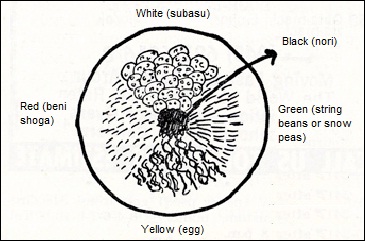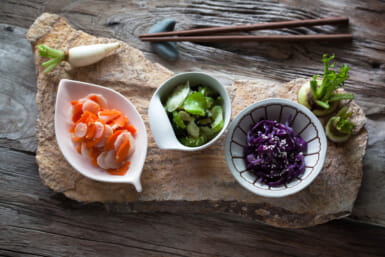with Elizabeth Andoh
My bridge-building buddy Ms. Horiguchi has told you all about tbat occurance-cum-occasion known as a “home party”, and I’ve agreed to help out on the recipe side of things. So, original plans have been slightly altered, but all for the better I hope.
Horiguchi-san favors karu age (that’s gingery fried chicken) and gomoku zushi (assorted vegetarian sushi) as main dishes and I certainly agree that they are both great “entertaining” foods. They can be made well in advance, served at room temperature (no last minute ovens or valuable refrigerator space used) and make wonderful snacks the following day if any should be left-over. The recipes here are intended for a gathering of 6-8 people (could stretch to more if other foods added), but feel free to double or triple the quantities as necessary.
KARA AGE (fried chicken)
ingredients:
- 1 kilo chicken pieces (fairly small pieces with skin and bone on)
- marinade: 1 1/2 – 2 teaspoons grated fresh shoga; 1/4 teaspoon grated garlic (optional); 1/3 cup sake; 1/3 cup shoyu
- coating: 1/3 cup flour; 1/3 cup cornstarch; salt and white pepper to taste
- oil for deep frying (salad oil with a drop of goma abura for aroma)
- lemon wedges, catsup, coarse salt, parsley etc. for garnishes
instructions:
1. Prepare the marinade: peel and grate shoga (and garlic), add shoyu and sake. Put the marinade in a shallow pan just large enough to hold the chicken pieces in one layer. Marinate for at least 15-20 minutes, turning often.
2. Prepare a mixture of the cornstarch, flour, salt and pepper. Dip the marinated chicken pieces (with only the marinade that naturally clings to the chicken) into the coating and coat thoroughly. Let the coated chicken stand on paper towels for 5-10 minutes until no longer completely white (the marinade has been “absorbed” into the coating).
3. Heat the oil for frying. There should be at least 2-3 inches of hot oil. Test temperature by throwing a pinch of dry flour in—if it sizzles immediately, the oil is ready.
4. Quickly fry 2-3 pieces of chicken at a time. Remove and drain on paper towels or a rack.
5. Lower heat of oil slightly and re-fry the chicken (3 or 4 pieces at a time) for about 3 minutes or until golden brown and very crisp. Remove and drain well.
6. Garnish with lemon wedges and parsley. Serve catsup and coarse salt in separate little dishes (for dipping).
notes:
1. shoga — fresh ginger root (garlic is ninniku)
2. goma abura — sesame seed oil, used for seasoning cooked foods or for adding a bit of aroma to cooking oil.
Next on the agenda is the sushi dish which really isn’t as complicated or difficult to make as it may at first appear. Most of the necessary components can be made 1-2 days in advance so that last-minute work consists of assemblage only. No need to refrigerate the final dish (in fact, the rice will become unnecessarily hard if you do)—the vinegar and sugar act as natural preservatives.
GOMOKU ZUSHI (assorted vegetarian sushi)
There are three categories of ingredients:
Group A (rice): 2 1/2 cups raw rice; a little less than 3 cups water
Group B (things to mix with rice): 1/2-1/3 cup Mitsukan’s Sushi Su (sweet vinegar dressing); already prepared yasai nimono
Group C (things to arrange on top of rice): subasu (recipe next month); tamago yaki (recipe next month); beni shoga (red pickled ginger) or amazu shoga (pink pickled ginger) string beans or snow peas (200 grams of either), boiled in salted water until barely tender (2-3 minutes); 2-3 squares nori, crumbled
instructions:
1. Make rice from Group A ingredients and allow at least 15 minutes self-steaming after cooking.
2. Dump out the warm cooked rice into a handai (wooden tub-like bowl pictured here) or a large bowl. Toss gently and fan to cool the rice a bit. Use a light touch or you’ll have a mushy mess.
3. Slowly add the sushi su while tossing; fan while lightly mixing it in. Taste and add more sushi su if necessary, but don’t overdo it — vinegar turns tarter upon cooling.
4. Toss in remaining Group B ingredients and mix thoroughly, but keep that light touch.
5. Allow the rice mixture to cool down (use this time for omelette making?) before mounding lightly on a very large platter.
6. Decorate the flavored sushi with subasu slices, beni shoga shreds, tamago yaki (omelette) shreds, and shredded snow peas or string beans. Crumble nori in the middle. (see illustration)
notes:
1. Sushi Su is the brand name (Mitsukan brand of bottled sushi-flavoring (uchizu). When buying, check label with someone who can read Japanese (like sales clerk).
2. beni shoga is the bright red pickled ginger and amazu shoga is either pale pink or pale yellow pickled ginger. Any of these can be bought in small vacuum sealed plastic packages for about ¥50-70. They keep for months and months (if refrigerated in their own syrup and kept covered) and make a wonderful condiment for fish or poultry.
3. nori—the thin sheets of crinkly seaweed. Asakusa nori (the larger sheets) is often flavored (becomes aji-tsuke nori then) or roasted (becomes yaki nori). There is also a greenish powdery type of nori called ao nori (“blue” seaweed). For this recipe use either yaki nori or roast asakusa nori yourself (much better aroma) by holding a sheet of the purplish-black seaweed over a low flame wave back and forth, careful not to burn it or you—for a few seconds. Then crumble or cut.
4. Prolonged contact with vinegar will turn green vegetables an unattractive brownish hue. So the snow peas or string beans can be boiled, cooled and shredded in advance, but should be placed on the sushi at the last minute.










